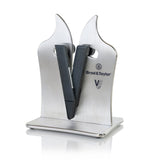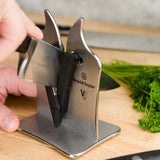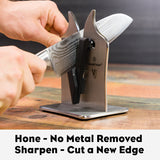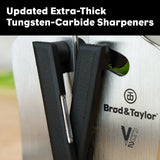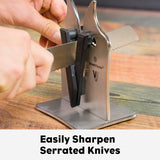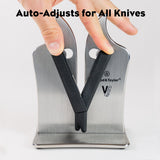Professional VG2 Knife Sharpener
Professional VG2 Knife Sharpener
Specifications
- Base Material: Solid 18/10 Stainless Steel (Professional) / PA66 Nylon (Classic)
- Knife Types: Sharpen Standard, Serrated, Pocket, and Japanese-Style Knives
- Safe for High-Quality Damascus Blades
- Sharpening Bar Material: Precision-ground ultra-hard tungsten carbide (HRC 63)
- Sharpener Lifetime: Sharpening bars last over 5-10 years with normal use (replacement sharpening bars available)
- Dimensions: 4¼ x 3½ x 6 in high (11 x 8.5 x 15 cm high)
- Weight: 29 oz / 814 g (Professional) / 10 oz / 290 g (Classic)
FAQ
I have never owned a knife sharpener. Why do I need one?
Knives are among the most used items in a kitchen. A sharp knife is actually safer to use than a dull knife. It won’t slip, requires less pressure and is a joy to use. Once you experience a truly sharp knife you will never believe you survived so long with a dull one.
I have my knives professionally sharpened. Why do I need my own sharpener?
Most people who use professional sharpening services wait until their knives are quite dull to have them sharpened. At that point, the only way to restore a sharp edge is by removing a substantial amount of metal during sharpening. With the Brød & Taylor sharpener, it is fast and easy to maintain a sharp edge at home, without the removal of any metal. This greatly reduces or may eliminate the need for reshaping the blade by removing metal. Along with avoiding the hassle and expense of taking your knives out to have them sharpened, you have the bonus of using a sharp knife every day.
How is the Brød & Taylor Knife Sharpener different from other sharpeners?
Traditional sharpening uses abrasives to grind away metal. Coarse abrasives can remove metal quickly, but they leave a rough edge. Fine abrasives work slowly. Abrasive materials become clogged with metal dust and can quickly loose effectiveness. Electric systems generate heat and must be used very carefully, or they can quickly damage a blade. The Brød & Taylor sharpener uses an extremely hard tungsten carbide sharpening surface that can actually cut a smooth bevel on a steel blade with a few quick strokes. More importantly, the sharpener will hone (fine sharpen) a blade without removing any metal. Regular honing will keep a knife sharp, reduce the need for removing metal from the blade edge, and greatly extend the life of a blade.
Can the sharpener damage my knives?
The Brød & Taylor sharpener is safe for virtually all types of metal knives (it will not sharpen ceramic knives). It is extremely easy to use, but you should read the instructions carefully. If you have used a traditional abrasive sharpener, you may be surprised how quickly the coarse sharpen technique will shape a blade. Only a few strokes are needed to shape the bevel on a dull knife. Use a light pressure and let the sharpener do the work. Honing (fine sharpening) and polishing do not remove any metal from the blade. In most cases, only the honing and polishing techniques should be used on fine knives such as those with Damascus steel blades. Fine knives often have a very small bevel angle that could be altered by coarse sharpening.
How do knives become dull?
Seems like a silly question, but it is perhaps one of the most important ones. Sharp knives begin to dull when the knife is used to cut or chop, causing the very edge of the blade to begin to bend and fold away – even microscopically. Eventually these areas break off and leave a dull edge. To keep a blade sharp, these bends need to be regularly pushed back into shape before they can cause damage to the blade. This can be achieved by regularly honing (fine sharpening) the knife. No metal is removed and the life of the blade is extended, because the need for coarse sharpening and removing metal from the blade edge is greatly reduced.
 For more info, read more about knife sharpening.
For more info, read more about knife sharpening.
How often do I need to sharpen a knife?
Knives should be honed (fine sharpened) frequently. Daily honing is best. No metal is removed and keeping the blade sharp actually extends the life of the blade. With frequent honing, you may never need to coarse sharpen your knife.
How should I sharpen Japanese knives?
Japanese blades may require some different sharpening techniques. In general, Japanese blades have a more narrow cutting angle (closer to 12 degrees) as compared to 15-16 for European blades. Additionally, some Japanese knives are single-beveled only on one side (usually the left) but this is not always the case. Examine your knife blade carefully in bright light to determine if it is a single or double bevel. Additionally, Japanese knives typically use steel that is much harder than Western or European knives and therefore is more brittle. DOUBLE BEVEL Japanese blades: 1. Coarse sharpening: This can be done, but use a very light touch to maintain the 12 degree bevel. Use sparingly. Many customers have their Japanese blades ground to the proper edge by the manufacturer and use our sharpener to maintain the edge with honing and polishing. More expensive Japanese knives may be made with great care and purchased for their aesthetic value as well as function. While our sharpener will create a sharp cutting edge on these knives, the bevel may not be exactly the same shape or have the beauty of the original hand-finished ground bevel. We highly recommend honing and polishing these knives regularly. This will not remove metal or change the shape of the bevel. It will keep the cutting edge aligned and sharp. This is particularly important with Japanese knives because the hard steel is more likely to chip or crack when the cutting edge begins to roll. 2. Honing: Recommend this regularly. It is even more important to do this regularly with Japanese blades as compared to western. Since the steel is very hard it is important to keep the blade aligned and avoid micro fractures on the edge. 3. Polishing: Highly recommended. This will keep the cutting edge extra sharp. SINGLE BEVEL Japanese blades: 1. Coarse sharpening: Do not coarse sharpen. The sharpener always cuts a double bevel edge. 2. Honing: Angle the knife handle to the LEFT so that only the left side of the knife touches the left sharpening bar. Keep the knife horizontal to the table and pull through. This will hone the left side of the blade. It is just the mirror image of the technique used for kitchen serrated knives. 3. Polishing: This can be done on the single sided blade. Since no metal is removed, it will safely polish any smooth blade to a high degree of sharpness. Draw the knife straight back and repeat. Polishing is safe and effective for single bevel Japanese knives and is done in the standard way.
How does the sharpener adjust to different blade angles?
The patented spring-action sharpening bars allow the blade to float, and automatically accommodate the natural angle of the knife’s bevel. If you press down harder on the blade, the angle of the bevel will increase. In general, just use a light touch and let the blade glide through.
Can the sharpener be used on ceramic blades?
No. The Brød & Taylor sharpening surfaces are extremely hard (HRC 95), but are designed only for use on metal blades. Most high-quality knives have blades with hardness in the HRC 60-69 range.
How long will the sharpeners last?
With normal household use, Brød & Taylor sharpeners are expected to last more than 5 years. Replacement sharpening bars are available for the Professional and Classic Models.
What materials are the sharpeners made of?
The sharpening bars are very rigid PA66 Nylon plastic. The sharpening surfaces are ultra-hard tungsten carbide (HRC 95). The Professional Sharpener’s base and springs are made of solid stainless steel. The base of the Classic model is also PA66 Nylon.
Are replacement sharpeners available?
Yes, replacement sharpening bars are available for the Professional and Classic Knife Sharpeners.
What is the best way to clean the sharpener?
A small soft brush (such as an inexpensive, synthetic bristle paint brush) can be used to dust off any reside from sharpening. Wipe the body with a damp towel to keep stainless steel glistening. When necessary, the sharpeners can be rinsed or washed with warm, soapy water, then wiped dry with a soft cloth.
Is the Brød & Taylor sharpener faster than traditional sharpeners with stones?
Sharpening with stones or other abrasives requires many steps from coarse to fine. Each step must eliminate all the scratches from the previous step to achieve a good result. The tungsten carbide system works much faster with a better result for most home cooks and chefs.
Will the sharpener make a knife sharper than traditional stone sharpening?
A skilled craftsmen with a full set of sharpening stones, such as expensive Japanese water stones or synthetic diamond stone, can create a blade of unrivaled sharpness (sometimes called “scary sharp,” such as a surgical scalpel). Mastering this sharpening skill takes the right equipment and years of practice. Practically speaking, knives this sharp are not required, or even desired, in the kitchen. With the Brød & Taylor sharpener, anyone can create an extremely sharp blade for kitchen use in seconds. The sharpener is so quick and easy to use, you will find yourself honing your knives regularly, so knives stay sharp.
What other things can I sharpen?
The Professional and Classic Knife Sharpener counter-top models excel at a variety of curved blades, such as the hooked paring knives. Woodworkers will be surprised at how easy it is to sharpen carving knives and even draw knife blades.
Can I sharpen scissors?
No, these sharpeners are not designed for sharpening scissors.
I have used other sharpeners with tungsten carbide that performed poorly. Why is this sharpener better?
There are many different grades of tungsten carbide, they are not all created equal. It is definitely a case of getting what you pay for. Bargain-bin, so-called tungsten carbide sharpeners are little more than poor quality sheet metal. Brød & Taylor’s Austrian-made tungsten carbide is extremely hard (Rockwell hardness HRC 95 — much harder than knives, which fall into the HRC 60-70 range) and is precision-ground with a very sharp cutting edge and polished, flat surfaces for honing and polishing. Visually compare the sharpeners to any other product and the difference is obvious.
How often should I hone (fine sharpen) compared to coarse sharpen?
Honing (fine sharpening) can and should be performed often, daily is best. With honing, no metal is removed and the blade is kept at optimum sharpness. If a knife is honed daily, it may never get dull enough to require coarse sharpening. Coarse sharpening is generally done only when a blade has become very dull. For a good quality knife, a good ratio to remember is 100 strokes honing (fine sharpen) to 1 stroke coarse sharpen.
How long does it take to sharpen a knife?
Sharpening with the Brød & Taylor sharpener only takes a few seconds. For a very dull knife, 4-6 strokes of coarse sharpening followed by 4-6 strokes of honing (fine sharpening) will give good results. If desired, use the Polish technique after honing to achieve an extra degree of sharpness.
How do you sharpen a serrated knife?
To sharpen a serrated knife, first inspect the blade edge and notice that one side is flat and the other is beveled (most serrated knives are beveled on the right as the knives are held in cutting position). For a knife that is beveled on the right, place it in the center “V” of the sharpener, then pivot the knife by moving the handle to the right so that the beveled knife edge is touching the silver-colored sharpening bar on the right. Pull the blade smoothly through the sharpener without twisting. The spring-loaded sharpening bar on the right side will hug the curve of each serration, sharpening the entire length of the blade and not just the points. Or, just look on the bottom of your sharpener for instructions!
Why would I want a specific angle on a knife blade?
Fine angle blades (such as a narrow angle of 12 degrees) are better for slicing and delicate work such as filleting. However, they will dull more quickly. A wider angle (such as 20 degrees) will hold up better to jobs such as rough chopping.
How many times do I need to pull the knife through the sharpener to coarse sharpen?
Generally, 4-6 strokes is all that is required, even on the dullest knives. Inspect the blade after a few strokes, it may sharpen faster than you expect.
I notice small shavings of metal after pre-sharpening (coarse sharpening). Is this ruining my knife?
Sharpening a very dull or nicked knife requires removing metal. Abrasive sharpeners create metal dust that often becomes embedded in the sharpener itself. The Brød & Taylor sharpener is not abrasive — it actually cuts the metal blade to a precise angle. The operation is very quick and can create small shavings of metal. This is analogous to the advanced technology used to make parts in computer-controlled machining equipment. In all cases, after sharpening, blades should be wiped clean with a damp cloth.
Does the sharpener remove any metal from the blade when fine sharpening (honing) or polishing?
Honing (fine sharpening) does not remove metal from the blade. The corners of the tungsten carbide sharpening bars push any irregularities or micro-bends in the blade edge back to an optimum “V” shape. Polishing knife edges is optional and does not remove metal. It uses the flat, smooth surfaces of the sharpening bars to burnish the blade at an angle slightly greater than the bevel angle (sometimes called a micro-bevel). This is the same technique used to produce razor blades, it produces the sharpest edge.
What is the difference between honing (fine sharpening) and polishing?
Honing (fine sharpening) uses the corner of the tungsten carbide sharpening bars to push any irregularities or micro-bends on blade edges back into an optimal “V” shape. For honing to be effective, the shape of the bevel must be correct and there must be an edge on the blade. Honing cannot create the proper bevel shape on a very dull knife, this needs to be done with coarse sharpening. With polishing, the very edge of the blade glides through the V-shaped intersection created by the flat surfaces on the two sharpening bars. Since the tungsten carbide sharpening bars are much harder than the knife blade, the blade edge is burnished to a very smooth surface. With the sharpening bars held apart, the angle of the burnish is slightly greater than the angle of the bevel. This quickly creates a very small micro-bevel that is extremely sharp. In fact, a micro-bevel is the same technique used to create the sharp edge on razor blades.
Will the sharpener repair badly damaged knives?
Since the sharpeners are designed to follow the contours of the blade (enabling them to sharpen serrated knives), they will not necessarily remove extremely deep nicks or gouges in the blade. However, even badly damaged knives can be sharpened and honed effectively, and often be used successfully in spite of the flaws.


















